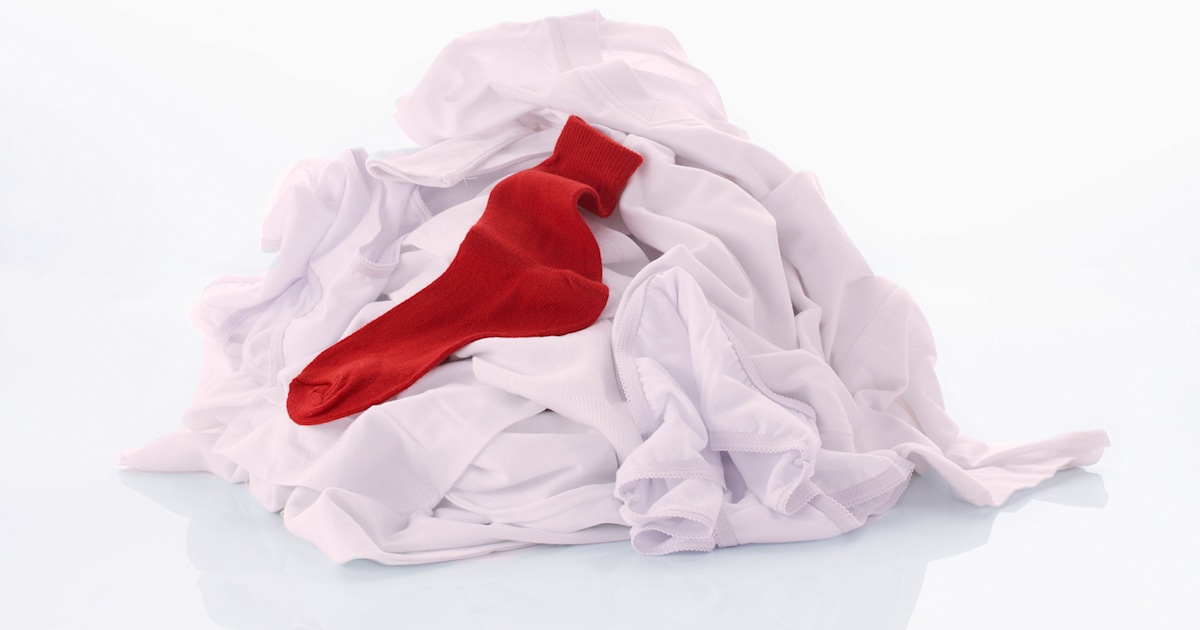To wash white clothes with color on them, use cold water and a color-safe bleach. Separate the white clothes with colored areas from other garments before washing.
Pretreat the colored areas with a stain remover, then wash the clothes in the washing machine with a color-safe detergent and the color-safe bleach. Washing white clothes with color on them can be a bit tricky, as you want to avoid the colors bleeding and staining the white fabric.
By following the appropriate steps and using the right products, you can effectively clean your white clothes without compromising the colored areas. We will share some tips on how to wash white clothes with color on them and keep them looking bright and fresh. Whether it’s a white shirt with colorful embroidery or a white dress with a printed pattern, we’ll guide you through the process of washing these delicate items effectively. Let’s dive in and learn how to maintain the crisp, clean look of your white clothes with color accents.

Credit: www.reddit.com
Table of Contents
Sorting Clothes
To wash white clothes with color on them, first sort your laundry by color to prevent bleeding. Then, use a gentle detergent and cold water to minimize fading. Finally, air dry or use the lowest heat setting on your dryer to maintain the garment’s brightness.
Separating White And Colored Items
Sort your clothing into whites and colors to prevent color transfer during washing.
Checking For Color Transfer Risk
Inspect each garment for color-fastness by testing in inconspicuous areas.
Check care labels for recommended washing instructions to avoid damage.

Credit: www.clorox.com
Pre-treating Stains
When dealing with white clothes that have color on them, pre-treating stains is a crucial step in ensuring that they come out looking clean and bright. By identifying stains, using appropriate stain removers, and following the right pre-treatment methods, you can effectively tackle challenging stains on white clothing with colored elements.
Identifying Stains On White Clothes
Before pre-treating any stains, it’s important to identify the type of stain on the white clothes. Common stains include food, oil, ink, and sweat. By closely inspecting the garment, you can determine the best pre-treatment method for each specific stain.
Using Appropriate Stain Removers
After identifying the type of stain, choose an appropriate stain remover. For food stains, a pre-treatment solution containing enzymes may be effective, whereas oil stains may require a solvent-based stain remover. When dealing with ink stains, a specialized stain remover designed for ink can be used. It’s important to choose the right stain remover to ensure effective pre-treatment.
Choosing The Right Detergent
To effectively wash white clothes with color on them, choose a gentle detergent that is specifically designed for mixed loads. Look for a product that is color-safe and has stain-fighting properties to maintain the brightness of your whites while protecting the color of your garments.
Selecting the right detergent is crucial in preserving the quality and appearance of your clothing.
Opting For Color-safe Detergents
When it comes to washing white clothes with color on them, choosing the right detergent is crucial to prevent color transfer and maintain the brightness of your whites. By opting for color-safe detergents, you can ensure that your white clothes stay crisp and stain-free. These detergents are specifically formulated to tackle dirt and stains without causing any color bleeding or fading. Consider the following factors when selecting a color-safe detergent for washing your white clothes with color on them: 1. Gentle formulas: Look for detergents that are specifically labeled as gentle or suitable for delicate fabrics. These formulas are usually milder and less likely to cause damage or discoloration to your clothes. Gentle detergents help preserve the integrity of the fabric and prevent any color bleeding. 2. Stain-fighting power: While it’s important to choose a gentle detergent, make sure it also has effective stain-fighting power. Look for detergents that are specifically designed to tackle tough stains while being gentle on fabrics. This ensures that your white clothes with color on them are not only clean but also stain-free. 3. pH-balanced: Opt for pH-balanced detergents as they are less likely to cause color bleeding or fading. pH-balanced detergents help maintain the natural pH level of the fabric, preventing any chemical reactions that may lead to color transfer or damage. 4. Enzyme-free: Some detergents contain enzymes that can break down protein-based stains. However, these enzymes can also react with dyes and pigments, leading to color fading or bleeding. To avoid this, choose enzyme-free detergents that will clean your clothes without compromising the color integrity. Remember, reading the labels and understanding the specifications of the detergent is essential to ensure you choose the right one for your white clothes with color on them. By opting for a color-safe detergent with gentle, stain-fighting, pH-balanced, and enzyme-free properties, you can effectively wash your white clothes without worrying about color transfer or fading.Selecting The Correct Water Temperature
When washing white clothes with color on them, selecting the correct water temperature is crucial in maintaining the brightness and vibrancy of the colors. The water temperature can affect the longevity and overall appearance of the colored patches on your white garments.
Impact Of Water Temperature On Color Protection
Water temperature plays a significant role in preventing the bleeding of colors and preserving the whiteness of your garments. Hot water can cause the colors to bleed and fade, whereas cold water may not effectively remove stains and dirt from the fabric. It’s essential to strike a balance to protect both the white fabric and the colored patches.
Recommended Settings For White Clothes With Color
When washing white clothes with color, it’s best to use warm water, typically around 40°C (104°F). This temperature is effective in removing stains and dirt while minimizing the risk of color bleeding. Additionally, pairing the warm water with a color-safe bleach can help maintain the brightness of the colors and keep the white fabric looking crisp and clean.
Washing Techniques
Discover effective washing techniques for white clothes with colors on them. Separate them initially to prevent bleeding. Use cold water and a gentle detergent to preserve colors and avoid fading. Take care to wash them inside out and air dry to maintain their brightness.
Gentle Washing Cycle For Mixed Loads
When it comes to washing white clothes with color on them, using a gentle washing cycle for mixed loads is crucial. This cycle is specially designed to minimize the risk of color bleeding onto your white garments. By selecting this cycle, you can ensure that your whites remain bright and vibrant while still effectively removing stains and dirt.
Utilizing Cold Water As A Protective Measure
To protect your white clothes with color on them, utilize cold water for washing. Cold water helps to prevent colors from bleeding onto your whites. By avoiding hot water, you can minimize the risk of color transfer and ensure your white garments stay crisp and clean. Remember, reducing heat is key to preserving the integrity of your whites.

Credit: www.today.com
Drying And Ironing
When washing white clothes with colors on them, proper drying and ironing techniques are essential to maintain the brightness and integrity of the fabrics.
Avoiding High Heat Settings
- Avoid using high heat when drying white clothes with color to prevent fading.
- Set the dryer to a low heat or delicate setting to preserve the colors.
- Hang brightly colored clothes to dry naturally to avoid color transfer.
Preventing Color Bleed During Ironing
- Iron white clothes with colors inside out to protect the colors from direct heat.
- Use a low heat setting and avoid excessive steam to prevent color bleeding.
- Place a thin cotton cloth over the colored areas while ironing to provide an extra barrier.
Storage Tips
- Keep white clothes separate from colorful ones.
- Store in a cool, dry place to prevent discoloration.
- Use breathable garment bags for protection.
- Organize clothes by color to minimize color transfer.
- Hang white clothes with colors on padded hangers to avoid creases.
- Avoid overcrowding to prevent friction and color transfer.
Frequently Asked Questions
How To Wash White Clothes With Colors?
Separate whites and colors. Wash whites in cold water with bleach. Wash colors in cold water with color-safe detergent. Use gentle cycle. Avoid mixing colors to prevent bleeding.
How Do You Wash A White Shirt With A Color Logo?
To wash a white shirt with a color logo, turn it inside out, use cold water, and gentle detergent. Wash separately and air dry to prevent color bleeding.
Can I Bleach A White Shirt With Colored Print On It?
Bleaching a white shirt with colored print may cause the colors to fade or run. It’s best to avoid bleaching such shirts to preserve the print. If you need to brighten the white part of the shirt, consider using color-safe bleach or seeking professional advice.
How Do I Get Colour Run Out Of White Clothes?
To remove color run from white clothes, try soaking them in a mixture of cold water and oxygen-based bleach. Then, wash the clothes in the washing machine using the hottest water safe for the fabric. Repeat if necessary.
Conclusion
To sum up, washing white clothes with color on them requires a strategic approach to avoid staining. By pre-treating stains, using cold water, and choosing the right detergent, you can keep your whites bright and vibrant. Following these tips will ensure your white clothes remain crisp and colorful for longer.
